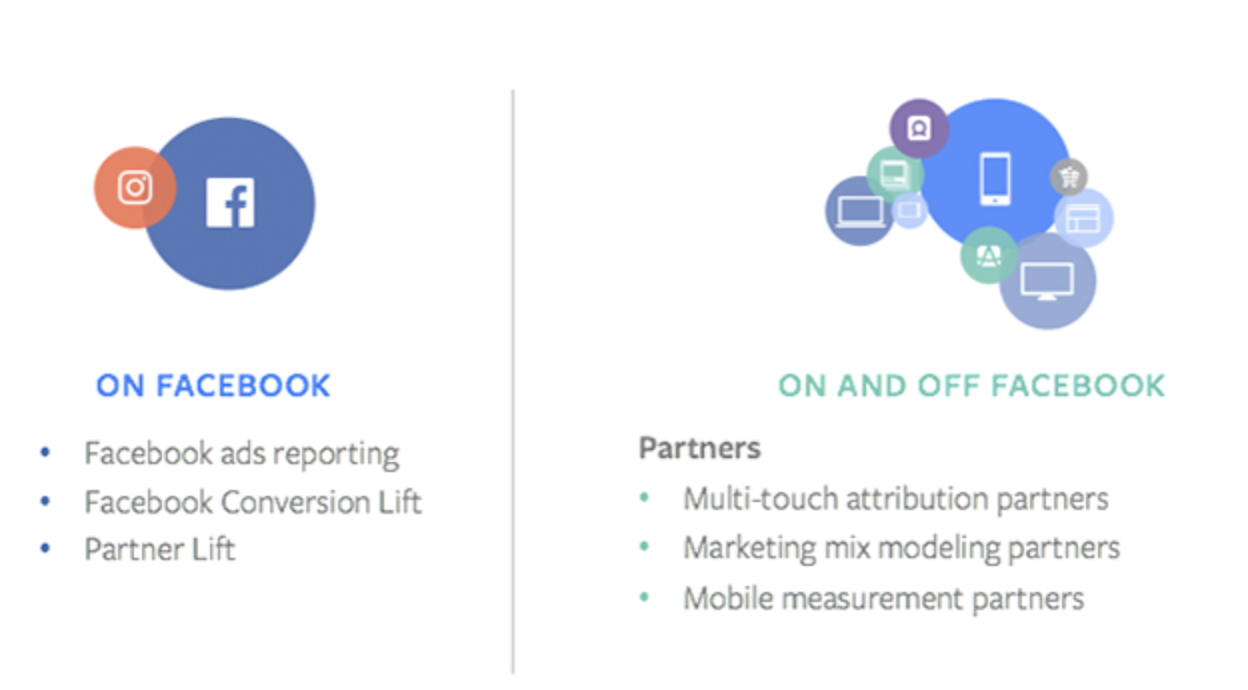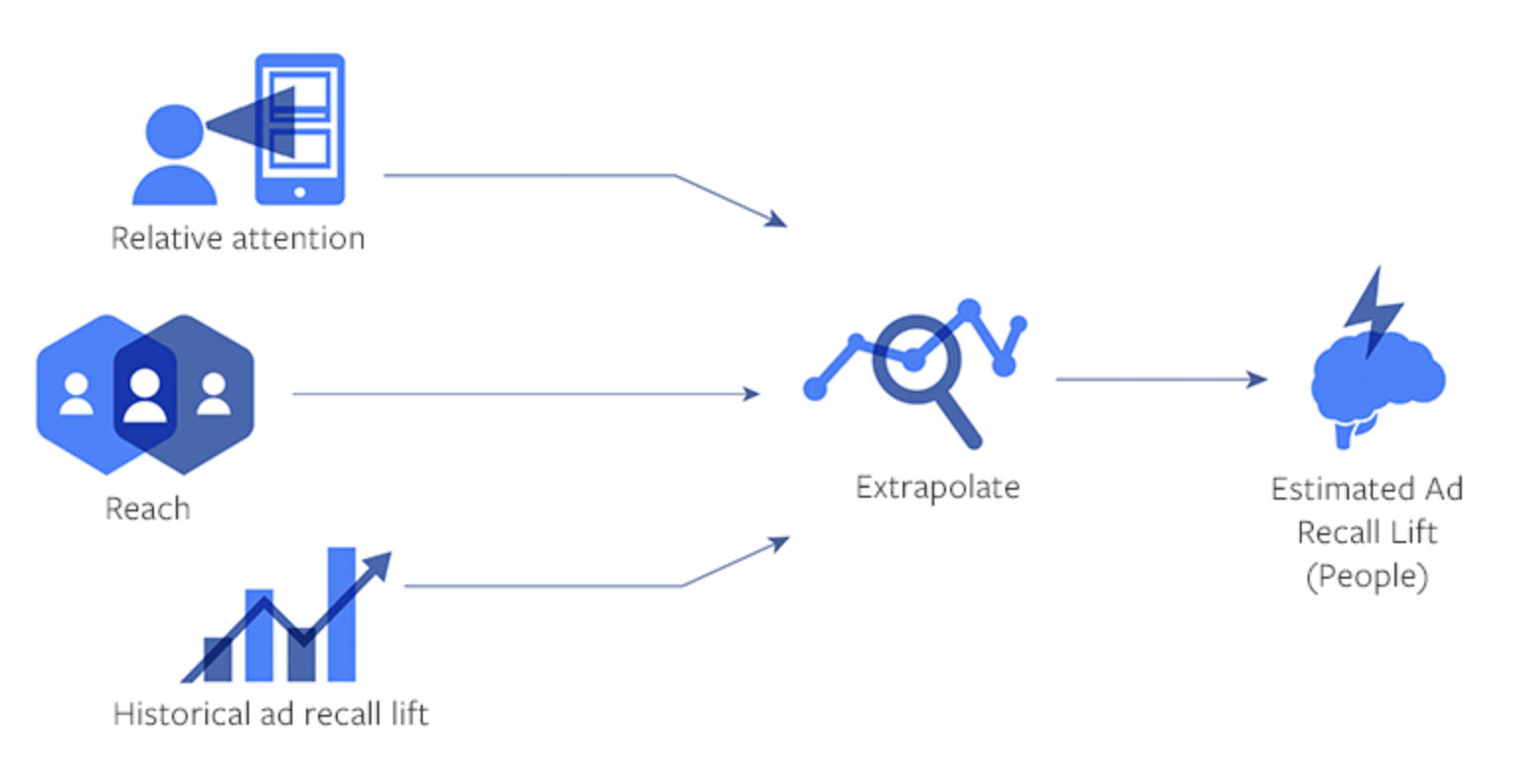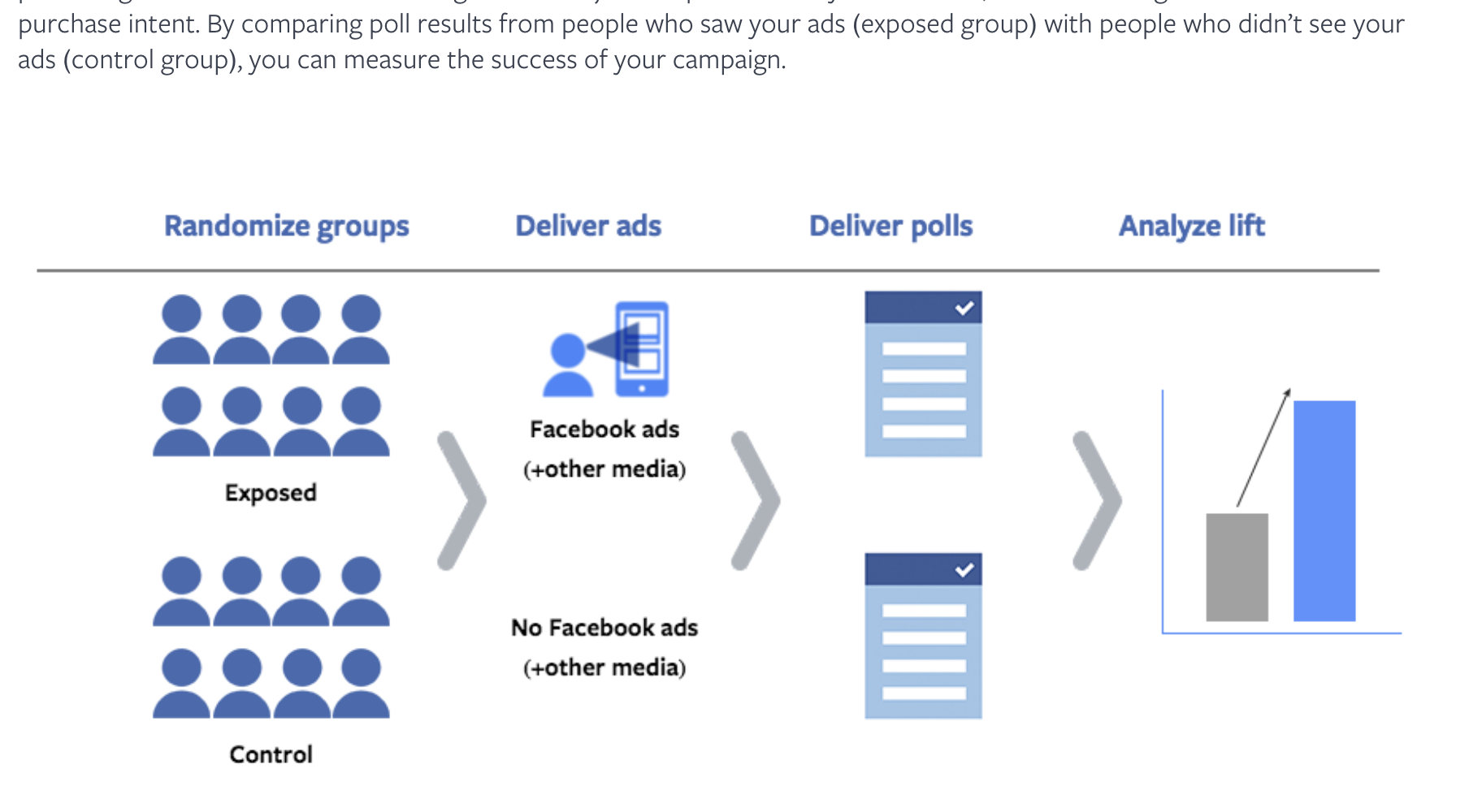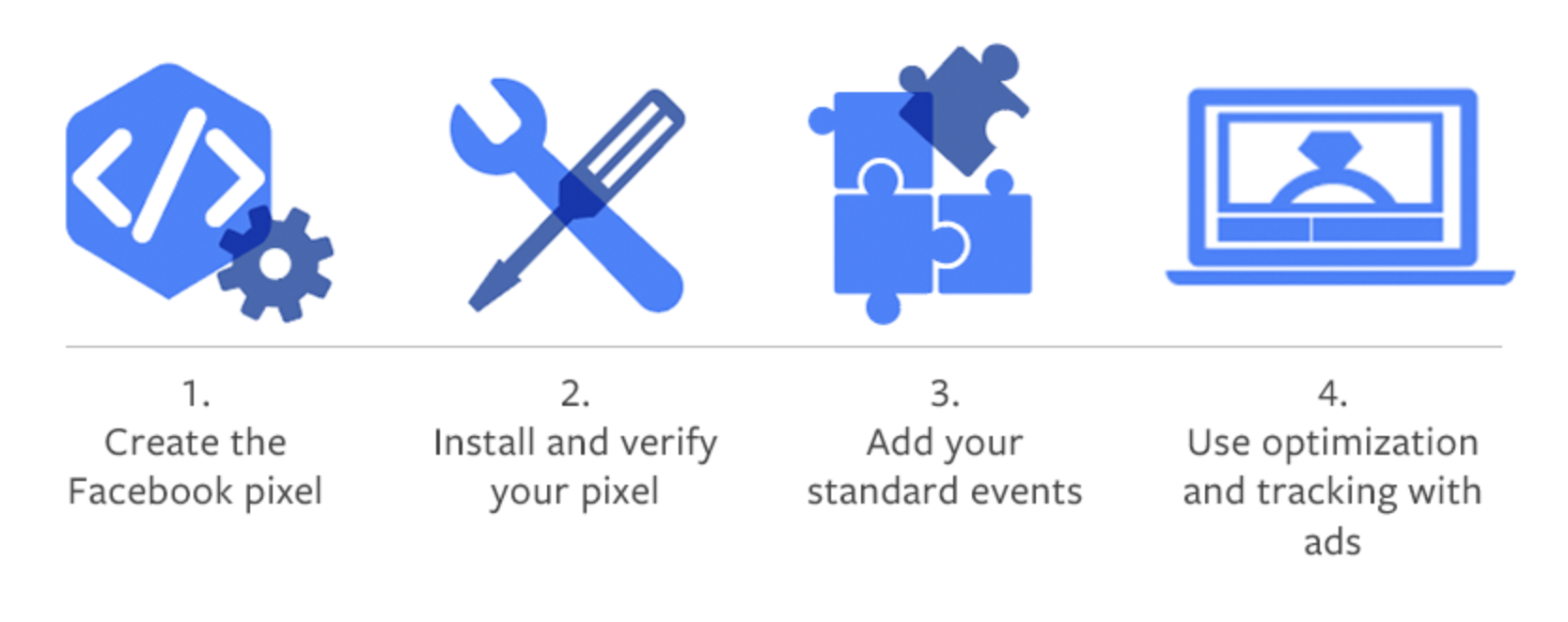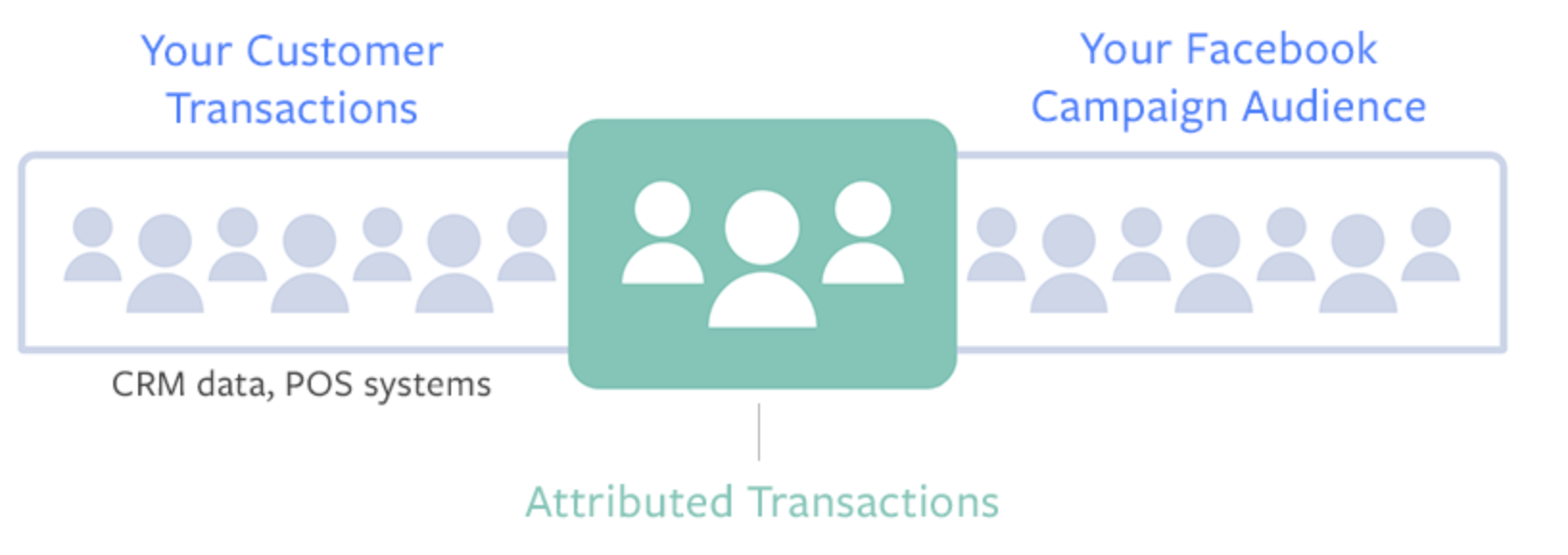Getting started with Facebook and partner measurement: Sales Outcomes
Facebook Solutions
- Facebook Ads Reporting: “How many conversions did my Facebook ads generate?” and “How much revenue can be attributed to my Facebook ads?”
- Facebook Conversion Lift: “Are my Facebook ads driving incremental buyers and conversions?”
Partner Solutions
- Partner Lift: How do my Facebook ads impact offline or in-store sales?”
- Multi-touch attribution partners: “How well do my ads drive conversions, across media channels and devices?”
- Marketing mix modeling partners: “What is the incremental contribution to sales/revenues/profits generated from each marketing channel, including Facebook?”
- Mobile measurement partners: “What publishers deserve credit for driving my app install or app engagement?”
Measuring Audience Outcomes
focus on the metrics Reach and Frequency in your ad reports. Reach is the number of people who saw your ads at least once, which is different from impressions, which may include multiple views of your ads by the same people. Frequency is the average number of times each person saw your ad.
Split testing helps you understand how different aspects of your ads affect campaign performance across Facebook, Instagram, and Audience Network. You can use Facebook split testing if you choose one of the following objectives for your campaign:
- Conversions
- App installs
- Lead generation
Each ad set tested has one distinct difference, called a variable. Your variable can be one of three: audience, placements, or delivery optimizations. Facebook will duplicate your ads and only change the one variable you choose. The performance of each ad set is measured in terms of the success metrics for your campaign objective and is then recorded and compared. The winning ad set is determined by comparing the cost per result of each ad set. The ad set with the lowest cost per result (Ex. cost per lead) is the winner.
Audience Insights
With Audience Insights, you’ll be able to see the following information for three different groups of people: people on Facebook, people connected to your Page, and people in a Custom Audience you’ve already created.
- Demographic information including trends about age and gender, relationship status, and job roles
- Information about where your audience is located and the languages they speak
- Purchase information (including online purchase behavior), which product categories they’re most likely to shop, and location data that may help you identify where to run special promotions or host events
Audience Insights uses third-party data from sources like Acxiom, Datalogix, and Epsilon
Reach partners
- Nielsen Digital Ad Ratings (DAR) – Available in Canada and the US
- Nielsen Total Ad Ratings (TAR) – Available in the US
- Nielsen Digital Content Ratings (DCR) – Available in the US
- Nielsen Total Content Ratings (TCR) – Available in the US*
Viewability verification partners
Viewability measures how many ad impressions were viewed by your audience and for how long. When combined with reach measurement, viewability can give you a full picture of how your media plan was delivered. You can measure and verify viewability metrics for Facebook and Instagram through select viewability partners. Viewability partners include comScore – available globally, Integral Ad Science – available globally, and Moat – available globally.
- Partner viewability measurement is directly integrated into Facebook mobile feed technology
- Partners review integration line by line
- Impression-level data collected by the third party
- The third party provides metrics to advertiser/brand/agency
- Partners do an independent end-to-end review and live testing
Measuring Brand Outcomes
For measuring Brand Outcomes, you should focus on the metric Estimated Ad Recall Lift (people) (EARL). Ad recall is measured when people exposed to an ad are later asked if they remember the ad; lift refers to the estimated difference in ad recall between people who saw the ad and those who didn’t. EARL is the best prediction and estimate that we can currently make about how many people are likely to remember seeing an ad if they were asked within two days of seeing it. Use this to compare the effectiveness of different creatives or target audiences.
You can measure EARL if you create a campaign using one of the following objectives:
- Brand Awareness
- Video Views
EARL* is calculated by looking at:
- Relative attention: How much time people spent looking at your ads compared to other content in their News Feed
- Reach: The number of people you reached with your ads
- Historical ad recall: Data from more than 300 Nielsen Brand studies that show the correlation of attention and reach to ad recall
By looking at the historical ad recall lift and real-time information on the reach and attention of the campaign, we’re able to extrapolate how much lift in ad recall your campaign is likely to produce.
Facebook Brand Lift
You can use Brand Lift to:
- Understand how well your campaign resonates with your audience.
- See how your campaign performs against the norms for campaigns in your industry and your region.
- See the demographic breakdowns (age, gender, TV viewership groups, and video view durations) that drive the highest lift.
please reach out to your Facebook Sales Representative.
- Nielsen Brand Effect – Available in Canada and the US
- Nielsen Cross-Channel Brand Effect – Available in Canada and the US
- Millward Brown Brand Lift Insights – Available in Canada and the US
Sales outcomes
Examples of conversion include people making a purchase on your website, installing your mobile app, or viewing a specific page of your website. The need to connect your CRM database with your social media to monitor offline conversions via phone calls. Implement Facebook pixel on your website and Facebook SDK for your app. Offline Conversions: Before running your campaign, connect your offline event sets through Business Manager or the API.
Using Conversion Lift, advertisers can determine the additional online and offline business outcomes attributable to people reached by Facebook ads across devices. When you run a Facebook campaign, Conversion Lift randomizes and splits your ad audience into two groups — one that sees your Facebook ads and another that doesn’t. As your campaign progresses, you can share your conversion data with Facebook, whether it happens online, offline, or in your mobile app. We’ll calculate the lift (the additional business you captured) by comparing conversions in the group that saw your ads and the one that didn’t and make the results available to you in Ads Manager.
You can also accurately attribute conversions to your Facebook campaigns by working with one of our partners. Our partners can help you:
- Neustar MarketShare – Available in Canada and the US
- VisualIQ – Available in Canada and the US
Marketing mix modeling (MMM) is a data-driven statistical analysis that quantifies the incremental sales impact and ROI of your marketing activities across channels, both online and offline. It helps you bring together large amounts of historical information from a variety of publishers and channels to make better marketing decisions about which ads — TV, digital, and print — are helping you meet your business goals.
MMM can help you answer common questions, including:
- How many sales did each of my marketing investments drive?
- What was the ROI of each marketing channel across all my brands?
- What media weight is optimal for each major marketing channel?
- What’s the ideal mix of 15-second vs. 30-second rolls, video vs. static, prime vs. non-prime TV?
- Which creative strategy has produced the highest sales impact?
- How would sales be impacted if I made X change to my marketing plan?
- If I needed to cut my marketing budget by X%, where should the dollars come from?
In addition to historical insights on what marketing activities drove sales, advertisers can use MMM to run forward-looking simulations to help them determine how to best allocate their budget by channel and by brand.
Exact MMM methods vary by country, vertical, and the company performing the analysis. But typically, MMM relies on some form of regression modeling, where a series of independent variables that are thought to impact sales (Ex. price point, product distribution, economic factors) are used to predict the dependent variable: sales volume over time.
The model assigns each media variable in the analysis (Ex. Facebook) a coefficient describing the historical relationship between increases in media support for the channel, and changes in sales volume.
For example, if there has been a strong relationship historically between increases in TV GRPs and increases in sales volume, the model will generally conclude that TV is driving sales volume. This would result in TV being assigned a high coefficient. On the other hand, if there is no sales increase whenever a print campaign is activated, print will get a very low coefficient, indicating there is very little relationship between investments in print and sales outcomes.
- Accenture – Available globally
- Neustar MarketShare – Available globally
- Track your complete Facebook media plan.
- Understand your ROI.
- Make accurate investment decisions across all media channels.
Facebook’s partner lift integrations can provide you with either:
- Lift measurement using your first-party data hosted within third-party data environments, and using Facebook lift platform for setup.
- Lift measurement for using grocery and retailer transaction data, primarily for consumer packaged goods (CPG) brands.
In North America, you can work with the following partners:
- 84.51 – Available in the US
- Acxiom – Available in the US
- Epsilon – Available in the US
- Nielsen Catalina Solutions (NCS) – Available in the US
- Oracle Data Cloud (Datalogix) – Available in the US
Measurement partners have access to the same technology that the Facebook SDK uses. This means that they can track your Facebook ad performance without needing to tag your ads with deep links or tagging parameters.
You should consider working with a mobile measurement partner if you want to get deeper insights about your campaign performance or aggregate your measurement across several ad networks.
Mobile measurement partners provide performance metrics like:
- Attribution
- Lifetime value
- Downstream conversions
- ROI
- Analysis across acquisition channels
We provide measurement partners with access to attribution data that enables them to more accurately attribute your Facebook ad performance.
The data they receive accounts for cross-device behavior, outcomes that were not proceeded by a click, and the ad interaction time which allows for deduplication of attribution claims. This data is reserved only for Facebook Marketing Partners specializing in measurement and cannot be accessed by non-badged measurement providers.
- adjust
- Always
- Apps Flyer
- Apsalar
- CyberZ
- Kochava
- Localytics
- Neustar MarketShare


